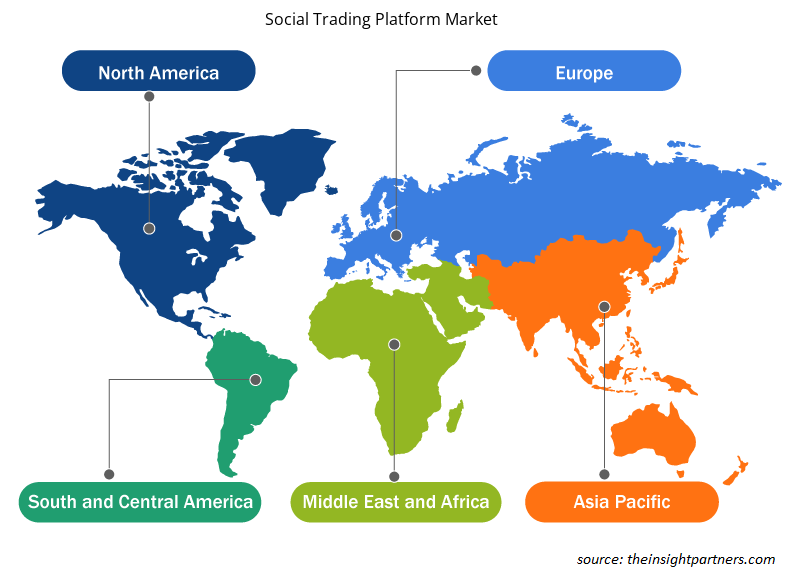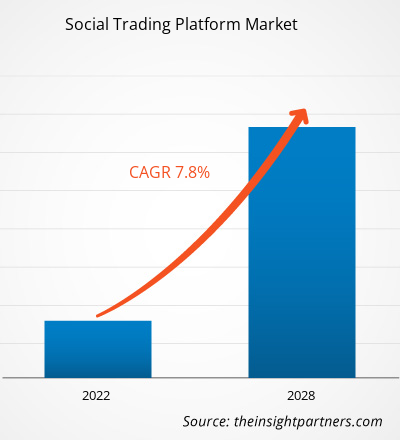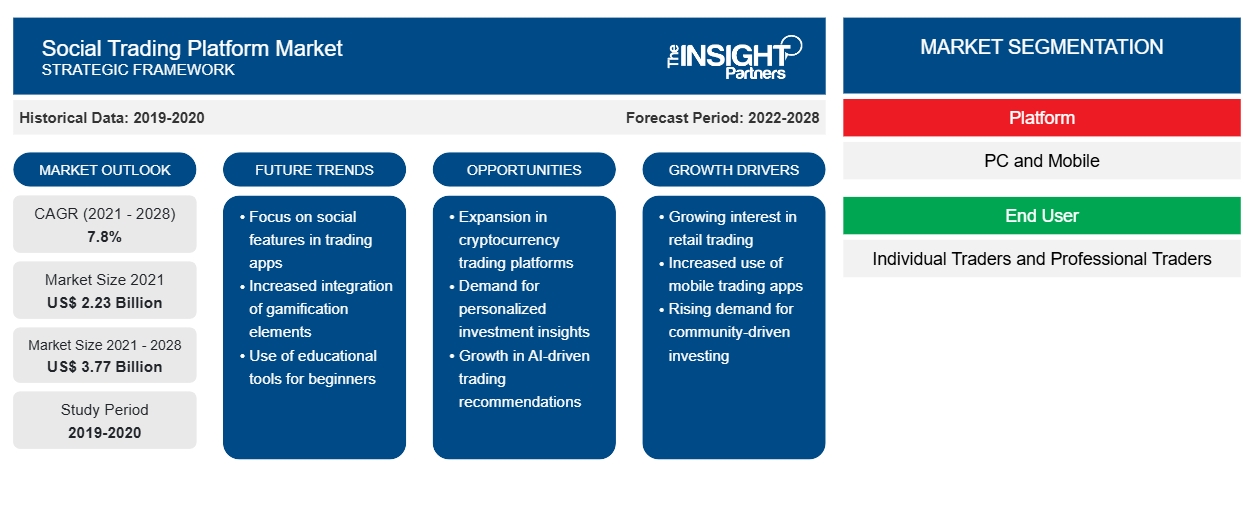Der Markt für Social-Trading-Plattformen soll von 2.229,56 Millionen US-Dollar im Jahr 2021 auf 3.774,17 Millionen US-Dollar im Jahr 2028 wachsen; zwischen 2021 und 2028 wird mit einer durchschnittlichen jährlichen Wachstumsrate von 7,8 % gerechnet.CAGR of 7.8% between 2021 and 2028.
Maßgeschneiderte Handelsplattformsoftware steigert effektiv den Umsatz der Organisationen und sorgt für eine bessere Kundenzufriedenheit. Die Händler nutzen häufig eine maßgeschneiderte Handelsplattform, da sie einfach zu verwenden ist. Die maßgeschneiderte Handelsplattform bietet den Kunden detaillierte und leicht lesbare Diagramme, Echtzeitstatistiken und maßgeschneiderte Berichtssysteme. So brachte ParagonEX (führendes Unternehmen im Bereich Finanztechnologie) im Mai 2021 eine vollständig anpassbare Handelsplattform auf den Markt, bei der seine Brokerkunden über jedes Detail des Erscheinungsbilds der Plattform entscheiden können. Die Anpassung umfasst jedes Element der Handelsplattform, was eine endlose Anpassung pro Broker oder Endbenutzer ermöglicht. Die neue Plattform ermöglicht jedem Broker ein einzigartiges Erscheinungsbild mit Elementen seiner Wahl, wodurch eine unverwechselbare Markenidentität geschaffen und das Profil und der Mix seiner Endbenutzer berücksichtigt werden.ParagonEX (financial technology leader) launched a fully customizable trading platform, allowing its broker clients to decide on every detail of the platforms' look and feel. The customization features every element of the trading platform, which allows for endless customization per broker or end-user. The new platform allows each broker to have a unique appearance, displaying elements of their choice, thus creating a distinct brand identity and catering to the profile and mix of their end-users.
Die Software bietet außerdem eine erweiterte und detaillierte Chartanalyse nach Kundenwunsch. Bei dieser Chartanalyse ist das Lesen und Verstehen bestimmter Daten in der Handelsbranche von entscheidender Bedeutung. Die erweiterte Chartanalyse bietet Benutzern einige flexible und benutzerdefinierte Funktionen, mit denen Diagramme nach den Anforderungen der Benutzer erstellt werden können. Abgesehen von den oben genannten Vorteilen bietet eine benutzerdefinierte Handelsplattform auch mehrere Optionen zum Lesen und Verstehen von Branchentrends, zum Vorhersagen von Preisschwankungen, zum Erstellen benutzerdefinierter und personalisierter Diagramme und zum Verwalten mehrerer Konten von einer einzigen Social-Trading-Plattform aus. All diese Vorteile tragen zum weltweiten Wachstum des Marktes für Social-Trading-Plattformen bei.
Passen Sie diesen Bericht Ihren Anforderungen an
Sie erhalten kostenlos individuelle Anpassungen an jedem Bericht, einschließlich Teilen dieses Berichts oder einer Analyse auf Länderebene, eines Excel-Datenpakets sowie tolle Angebote und Rabatte für Start-ups und Universitäten.
-
Holen Sie sich die wichtigsten Markttrends aus diesem Bericht.Dieses KOSTENLOSE Beispiel umfasst eine Datenanalyse von Markttrends bis hin zu Schätzungen und Prognosen.
Auswirkungen der COVID-19-Pandemie auf den globalen Markt für Social-Trading-Plattformen
Social-Trading-Plattformen waren während der digitalen Transformation von Finanzinstituten sowie von Banklösungen und -dienstleistungen weit verbreitet. Laut dem von Business Wire veröffentlichten Artikel beliefen sich die Ausgaben für die digitale Transformation im Jahr 2019 auf 1,18 Billionen US-Dollar, ein Anstieg von 17,9 % gegenüber 2018, und die Notwendigkeit der digitalen Transformation unterstützte das Wachstum des Marktes für Social-Trading-Plattformen.
Darüber hinaus wirkten sich die Lockerung der Lockdown-Maßnahmen und der Anstieg der Beschäftigungsquoten in den Jahren 2021 und 2022 positiv auf das Wachstum des Marktes für Social-Trading-Plattformen aus. Der zunehmende Trend zu Investitionen in Kryptowährungen wirkte sich positiv auf das Marktwachstum aus. Laut dem Free Press Journal boomte Bitcoin und überraschte die ganze Welt, von etwa 7.000 US-Dollar im März 2020 auf über 54.000 US-Dollar bis Juni 2021.lockdown measures and gain in the employment rates positively impacted the social trading platform market growth. The increase in the trend of investment in cryptocurrency positively impacted market growth. According to the Free Press Journal, Bitcoin boomed and astonished the whole world, from approximately US$ 7,000 in March 2020 to more than US$ 54,000 till June 2021.
Markteinblicke für Social-Trading-Plattformen
Steigende Vorteile der Integration von Chatbots in HandelsplattformenChatbots with Trading Platforms
Die Online-Handelsbranche wächst mit der Entwicklung fortschrittlicher Technologien erheblich. Aufgrund der COVID-19-Pandemie hat sich das Online-Handelsmuster im Jahr 2020 verstärkt. Laut dem von Chatbots Life veröffentlichten Artikel wurde außerdem beobachtet, dass im Jahr 2021 weltweit über 2,14 Milliarden Menschen Waren und Dienstleistungen online kauften, was zu einer rasanten Entwicklung der Online-Handelsbranche weltweit führte. Aufgrund der rasanten Entwicklung der Online-Handelsbranche wird es für Händler immer schwieriger, mit dem Tempo der Veränderungen Schritt zu halten, um auf dem Laufenden zu bleiben und alle Aufgaben zu bewältigen. Daher ist die Integration KI-basierter Chatbots für Handelsorganisationen unerlässlich, um das Kundenerlebnis und die Produktivität zu verbessern.evolvement of the online trading industry globally. Due to the rapid evolvement of the online trading industry, a challenge for traders to keep up with the pace of change to stay current and process all the tasks is also increasing side-by-side. Thus, integrating AI-based chatbots is essential for trading organizations to enhance the customer experience and productivity.
Chatbots übernehmen die Rolle persönlicher Makler, indem sie Händlern bei Aufgaben und Vorgängen helfen. Sie führen gründlichere Recherchen durch, erhalten Einblicke in Käufer, ihre Bedürfnisse, Probleme und Erwartungen und bieten rund um die Uhr Support und beantworten Fragen. Sie helfen Benutzern, über die neuesten Markttrends auf dem Laufenden zu bleiben, die den Fortschritt des Unternehmens verbessern können. Darüber hinaus können Benutzer durch die Integration von Finanzbots in das System den Handelsprozess automatisieren, sodass er rund um die Uhr ohne Unterbrechungen im Hintergrund ausgeführt wird. Die Lösung hilft Benutzern, über die Markttrends auf dem Laufenden zu bleiben und zum richtigen Zeitpunkt die richtigen Geschäfte zu tätigen. perform the role of personal brokers by helping traders with tasks and operations. They perform more profound research, get insights about buyers, their needs, pains, and expectations, and provide 24/7 support and respond to queries. They help users to remain up to date with the latest market trends that can improve the company's progress. Further, integrating financial bots into the system allows users to automate the trading process to run in the background 24/7 without any breaks. The solution help users stay on top of the market trends and make the right trades at the right time.
Darüber hinaus hilft die Integration von Chatbots in die Online-Handelsplattformen der Benutzer dabei, die enorme Datenmenge zu verarbeiten und zu analysieren und mathematische Berechnungen effektiv durchzuführen. Darüber hinaus sind Trading-Chatbots ein hervorragendes Lernwerkzeug, insbesondere für neue Händler. Daher helfen die zahlreichen Vorteile von Chatbots im Online-Handel Unternehmen dabei, wettbewerbsfähig zu bleiben und die Chancen auf langfristigen Erfolg zu verbessern. Daher steigt die Nachfrage nach Chatbots auf Social-Trading-Plattformen.
Plattformbasierte Markteinblicke
Basierend auf der Plattform ist der Markt für Social-Trading-Plattformen in PC und Mobilgeräte unterteilt. Im Jahr 2021 führte das Mobilsegment den Markt für Social-Trading-Plattformen an und hatte den größten Marktanteil.
Endbenutzerbasierte Markteinblicke
Basierend auf dem Endnutzer kann der Markt für Social-Trading-Plattformen in Einzelhändler und professionelle Händler unterteilt werden. Im Jahr 2021 hatte das Segment der Einzelhändler den größten Marktanteil.
Regionale Einblicke in den Markt für Social-Trading-Plattformen
Die regionalen Trends und Faktoren, die den Markt für Social-Trading-Plattformen im Prognosezeitraum beeinflussen, wurden von den Analysten von Insight Partners ausführlich erläutert. In diesem Abschnitt werden auch die Marktsegmente und die Geografie von Social-Trading-Plattformen in Nordamerika, Europa, im asiatisch-pazifischen Raum, im Nahen Osten und Afrika sowie in Süd- und Mittelamerika erörtert.

- Erhalten Sie regionale Daten zum Markt für Social-Trading-Plattformen
Umfang des Marktberichts zur Social-Trading-Plattform
| Berichtsattribut | Details |
|---|---|
| Marktgröße im Jahr 2021 | 2,23 Milliarden US-Dollar |
| Marktgröße bis 2028 | 3,77 Milliarden US-Dollar |
| Globale CAGR (2021 - 2028) | 7,8 % |
| Historische Daten | 2019-2020 |
| Prognosezeitraum | 2022–2028 |
| Abgedeckte Segmente |
Nach Plattform
|
| Abgedeckte Regionen und Länder |
Nordamerika
|
| Marktführer und wichtige Unternehmensprofile |
|
Dichte der Marktteilnehmer auf Social-Trading-Plattformen: Die Auswirkungen auf die Geschäftsdynamik verstehen
Der Markt für Social-Trading-Plattformen wächst rasant, angetrieben von der steigenden Nachfrage der Endnutzer aufgrund von Faktoren wie sich entwickelnden Verbraucherpräferenzen, technologischen Fortschritten und einem größeren Bewusstsein für die Vorteile des Produkts. Mit steigender Nachfrage erweitern Unternehmen ihr Angebot, entwickeln Innovationen, um die Bedürfnisse der Verbraucher zu erfüllen, und nutzen neue Trends, was das Marktwachstum weiter ankurbelt.
Die Marktteilnehmerdichte bezieht sich auf die Verteilung der Firmen oder Unternehmen, die in einem bestimmten Markt oder einer bestimmten Branche tätig sind. Sie gibt an, wie viele Wettbewerber (Marktteilnehmer) in einem bestimmten Marktraum im Verhältnis zu seiner Größe oder seinem gesamten Marktwert präsent sind.
Die wichtigsten Unternehmen auf dem Markt für Social-Trading-Plattformen sind:
- eToro
- A-Handel
- ZuluTrade
- Tornado
- MetaQuotes
Haftungsausschluss : Die oben aufgeführten Unternehmen sind nicht in einer bestimmten Reihenfolge aufgeführt.

- Überblick über die wichtigsten Akteure auf dem Social-Trading-Plattform-Markt
Markteinblicke basierend auf Anlageklassen
Basierend auf der Anlageklasse kann der Markt für Social-Trading-Plattformen in Aktien, Rohstoffe, Derivate, Kryptowährungen und andere unterteilt werden. Im Jahr 2021 hatte das Kryptowährungssegment den größten Anteil am globalen Markt für Social-Trading-Plattformen.
Akteure auf dem Markt für Social-Trading-Plattformen verfolgen verschiedene Strategien, wie Fusionen und Übernahmen, um ihre Position auf dem Markt für Social-Trading-Plattformen zu behaupten. Nachfolgend sind einige Entwicklungen der wichtigsten Akteure aufgeführt:
- Im Januar 2022 erweiterte eToro sein Anlageangebot in den USA um US-Aktien und ETFs (börsengehandelte Fonds).
- Im Dezember 2021 hatte eToro den Start seines eToro Money-Programms für britische Verbraucher angekündigt. eToro Money lässt sich in das eToro-Anlagekonto eines Benutzers integrieren und ermöglicht ihm, sofort Bargeld einzuzahlen und abzuheben sowie seine Kryptowährungen und Finanzen an einem Ort zu verwalten.
Firmenprofile
- eToro
- A-Handel
- ZuluTrade
- Tornado
- MetaQuotes
- PrimeXBT
- Pepperstone Markets Limited
- Tickmill
- Octa Markets Incorporated
- Assetgro Fintech Pvt. Ltd (Stockgro)
- Öffentliche Holding, Inc.
- Naga Group AG
- Schneeball X
- Historische Analyse (2 Jahre), Basisjahr, Prognose (7 Jahre) mit CAGR
- PEST- und SWOT-Analyse
- Marktgröße Wert/Volumen – Global, Regional, Land
- Branchen- und Wettbewerbslandschaft
- Excel-Datensatz
Aktuelle Berichte
Erfahrungsberichte
Grund zum Kauf
- Fundierte Entscheidungsfindung
- Marktdynamik verstehen
- Wettbewerbsanalyse
- Kundeneinblicke
- Marktprognosen
- Risikominimierung
- Strategische Planung
- Investitionsbegründung
- Identifizierung neuer Märkte
- Verbesserung von Marketingstrategien
- Steigerung der Betriebseffizienz
- Anpassung an regulatorische Trends























 Kostenlose Probe anfordern für - Markt für Social-Trading-Plattformen
Kostenlose Probe anfordern für - Markt für Social-Trading-Plattformen